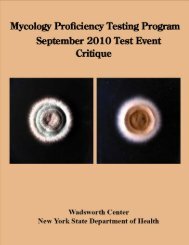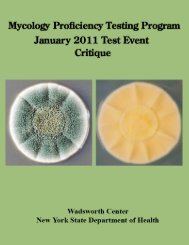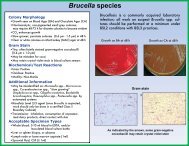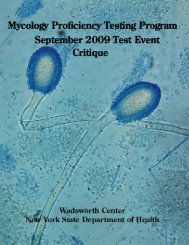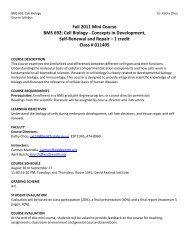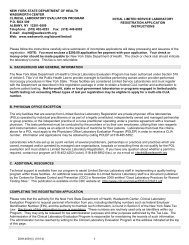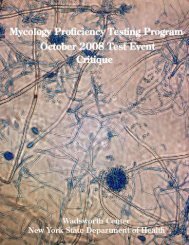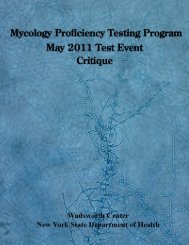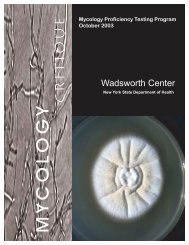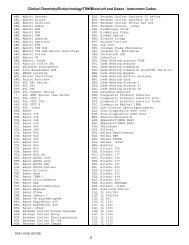September 2007 - Wadsworth Center
September 2007 - Wadsworth Center
September 2007 - Wadsworth Center
You also want an ePaper? Increase the reach of your titles
YUMPU automatically turns print PDFs into web optimized ePapers that Google loves.
M-5 Penicillium sp.Source: SinusScoring:No. LaboratoriesReferee Laboratories with correct ID: 9Laboratories with correct ID: 71Laboratories with incorrect ID: 7(Paecilomyces sp.) (6)(Scedosporium apiospermum) (1)Clinical Significance: Penicillium spp. other than Penicillium marneffei are commonly considered aslaboratory contaminants. Penicillium spp. have been isolated from patients with keratitis, endophtalmitis,otomycosis, necrotizing esophagitis, pneumonia, endocarditis, peritonitis, and urinary tract infections. Somespecies are known to produce mycotoxins, which are nephrotoxic and carcinogenic.Ecology: Penicillium spp. are widespread and are found in soil, decaying vegetables and fruits, and the air.Laboratory Diagnosis:1. Culture –Penicillium sp. grew rapidly, velvety to powdery in texture. The colony was initially white andthen became blue green, gray green, olive gray in time (Figure 9A). The plate reverse was pale toyellowish (Figure 9B).2. Microscopic morphology – Lactophenol cotton blue or Calcofluor mounts showed septate hyalinehyphae, simple or branched conidiophores, metulae, phialides. Metulae were secondary branches thatform on conidiophores. The brush-like clusters of phialides, are referred to as "penicilli". The unicellularconidia were round, and formed chains at the tips of the phialides (Figure 10).3. Differentiation from other mold – Penicillium sp. can be differentiated from Paecilomyces by havingflask-shaped phialides and globose to subglobose conidia; from Gliocladium by having chains of conidia;and from Scopulariopsis by forming phialides.4. In vitro susceptibility testing – In general, Penicillium sp. is susceptible to amphotericin B, ketoconazole,itraconazole, and voriconazole.5. Molecular tests – Internal transcribed spacer (ITS) regions can be used for Penicillium spp. identification.Comments: Five laboratories reported this specimen as Paecilomyces sp., which has thin phialides withelongated tips, but Penicillium sp. has phialides with thicker apices.Further Reading:1. Deshpande, S. D., and G. V. Koppikar. 1999. A study of mycotic keratitis in Mumbai. Indian J PatholMicrobiol. 42: 81-87.2. Keceli, S., Yegenaga, I., Dagdelen, N., Mutlu, B., Uckardes, H., and Willke, A. 2005. Case report:peritonitis by Penicillium spp. in a patient undergoing continuous ambulatory peritoneal dialysis. Int UrolNephrol.37: 129-131.3. Noritomi, D.T., Bub, G.L., Beer, I., da Silva, A.S., de Cleva, R., and Gama-Rodrigues, J.J. 2005.Multiple brain abscesses due to Penicillium spp infection. Rev Inst Med Trop Sao Paulo. 47: 167-170.4. Zanatta, R., Miniscalco, B., Guarro, J., Gené, J., Capucchio, M.T., Gallo, M.G., Mikulicich, B., Peano,A. 2006. A case of disseminated mycosis in a German Shepherd dog due to Penicillium purpurogenum.Med Mycol. 44: 93-97.27



